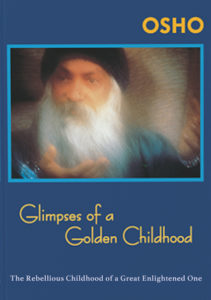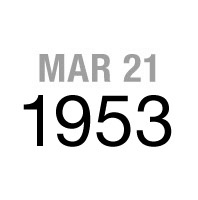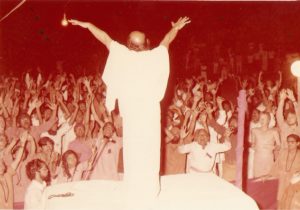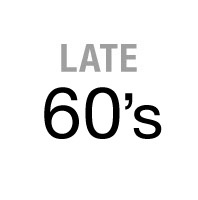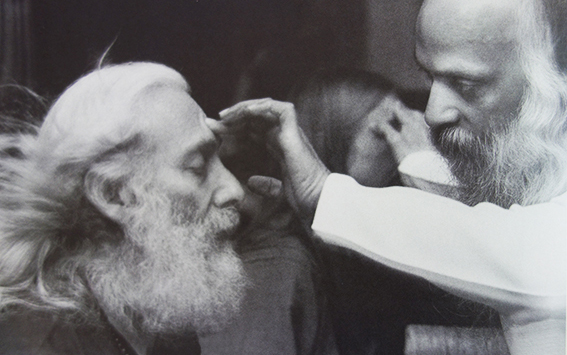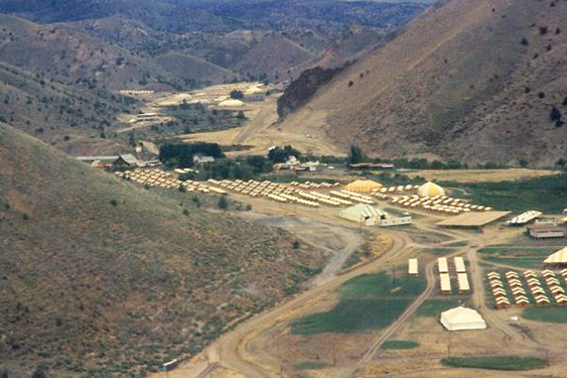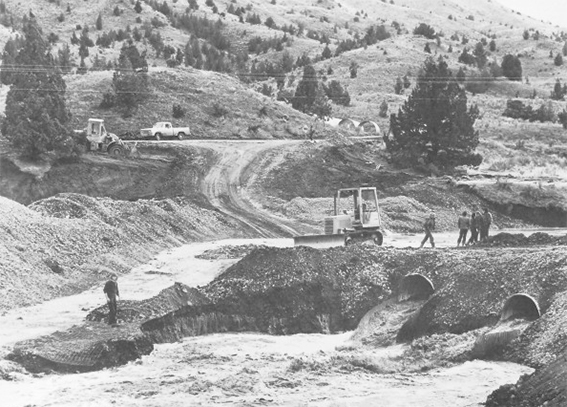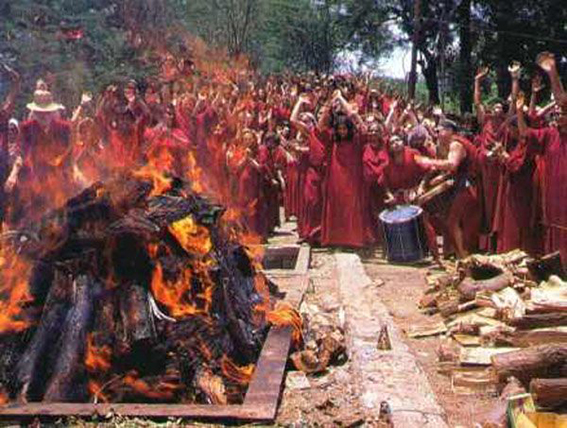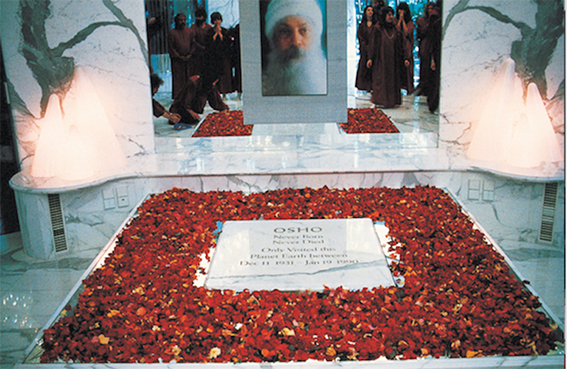Biography
1931 | 1951 | 1953 | 1956 | 1958 | 1960’s | 1974 | 1981 | 1982 | 1983 | 1984 | 1985 | 1986 | 1987 | 1988 | 1989 | 1990
A Rebellious Child
Osho is born in Kuchwada, a small rural village in the state of Madhya Pradesh, central India, on December 11, 1931.
He is the eldest of 11 children of a Jaina cloth merchant. He is described as independent and rebellious as a child, questioning the social expectations and religious beliefs his family and teachers try to impose on him. As a youth he experiments with meditation techniques from many different traditions. See here for some stories about his unusual childhood.
He talks about these years in his book Glimpses of a Golden Childhood.
Enlightenment
___
Osho is fascinated by mystical spirituality from an early age. He seeks out and questions every priest and holy man he can find, regardless of their religion. He practises every meditation technique he can discover from ancient books, including all 112 techniques from Shiva’s 2000-year-old Vigyan Bhairav Tantra. He explores the yoga meditation techniques of Patanjali. He infamously spends a moonless night in a temple known for venomous snakes, allowing them to crawl over his body.
His intense experiments with meditation culminate in an explosion of enlightenment (self-realisation) when he is 21.
University Years
Osho attends two university colleges. He is asked to leave the first when his logics professor complains to the Vice-Chancellor that he cannot teach because Osho will not stop asking questions. Admonished by the professor not to argue, Osho points out that this defeats the whole purpose of being in a class on philosophy and logic. Exasperated, the professor, an old and respected man, gives the ultimatum that ‘either he leaves or I leave’. The Vice-Chancellor finds Osho a place in another college, but his reputation has preceded him and a condition is made that he not attend the philosophy classes at the new college. Osho agrees happily.
He prefers to teach himself in the library, where he continues his voracious reading. He also continues to torture his professors. He notices that few of them ever visit the library, and he peppers them with questions about up-to-date material in their field. When he discovers one professor who will never admit that he does not know something, Osho traps him by quoting in class a fictitious book, Principia Logica. When the professor says he has read the book, Osho exposes him to the Vice-Chancellor.
‘In college he did not spare a teacher who spoke an untruth, and he rebelled against tradition and shocked people by his unconventional mode of thinking,’ reports the New Delhi Patriot in a review of Osho’s life published in 1981.
Despite antagonising his professors, in 1957 Osho gains a first-class MA in logic, philosophy and literature.
He is also the All-India Debating Champion and Gold Medal winner in his graduating class.
Professor and Controversial Speaker
Aged 26, he is appointed Professor of Philosophy at the University of Jabalpur, where he teaches until 1966.
Described as a ‘brilliant but unorthodox professor’, even his teaching methods create controversy. However, he is immensely popular and his lectures have to be moved to the largest hall in the university.
A powerful and passionate debater, he also travels widely in India during these years, challenging orthodox religious leaders in public debates, speaking on the radio, and addressing large public gatherings.
The press report:
An exciting and entertaining speaker, he is initially invited to address many prestigious conferences. However, his delight in controversy, and his endless and uncompromising attacks on any and every deeply-rooted belief that he feels is not based on truth or logic, soon make him an enemy of the establishment. He tears into organised religion, delivering a scathing indictment of the Shankaracharya of Puri, the high priest of Hinduism, at the Second World Hindu Religion Conference at Patna. He vehemently attacks India’s long-standing love affair with poverty, condemning the revered Gandhi for crippling India with his anti-modern, anti-technology thinking. Gandhi’s preoccupation with the poor, he says, has hindered their liberation from poverty. What India needs to escape its backwardness is capitalism, science, modern technology and birth control.
In the same vein, he lashes out at another national hero, Mother Teresa, for manipulating the orphan problem in order to create more converts to Catholicism. Her stance against birth control, he says, shows that she is not trying to fight poverty, merely trying to create more Hindu babies which she can ‘save’ for Catholicism, winning a Nobel Prize in the bargain. Poverty can only be eradicated, he maintains, through ‘absolute’ birth control and education. He insists that wealth is a necessary precursor to spiritual seeking, poor people being too preoccupied with food and other survival basics to think about spiritual needs. In a country where poverty and renunciation are blindly associated with sainthood, these views are not surprisingly considered shocking.
A few years later he causes further outrage when he begins to lecture that sex is a path to enlightenment.
Public Talks Around India
___After nine years of teaching, Osho leaves the university to devote himself entirely to the raising of human consciousness.
On a regular basis, he begins to address gatherings of up to 50,000 people in the open-air maidans of India’s major cities.
Creating the ‘New Man’
After leaving the university, Osho is free to concentrate full time on his vision of inspiring a new kind of man – a person who will be free of the limitations, guilt and expectations imposed by society and religion. A person who will be free to be authentic, innocent and honest, who will be capable of expanding beyond the limitations of their mind to experience the super consciousness of enlightenment or self-realisation.
Around this time, his Hindi talks become available in English translations. And the first Western seekers begin to arrive.
The Beginning of Sannyas and Meditation Camps
Osho – at this time called Bhagwan Shree Rajneesh – begins to initiate seekers into Neo-Sannyas or discipleship, a path of commitment to self-exploration and meditation which does not involve renouncing the world or anything else. Osho’s understanding of ‘Sannyas’ is a radical departure from the traditional Eastern viewpoint. For him it is not the material world that needs to be renounced but the conditionings and belief systems that each generation imposes on the next. He encourages his sannyasins to celebrate life totally rather than abstain from life.
The number of sannyasins grows rapidly, and Osho largely stops accepting invitations to give huge public talks. Instead he begins to devote his energies entirely to working deeply with these new disciples.
He conducts intense 10-day meditation camps where he introduces a number of new, seemingly bizarre, techniques he has developed specifically for the stresses of modern living.
‘It is very difficult for contemporary people to enter directly into meditation, because repressions and inhibitions have accumulated in their unconscious like a rock wall. So I have created cathartic techniques as a preparation for meditation, to remove that rock. Once it is removed, then you can begin the right meditation. There are 112 techniques which you can experiment with to find the one which clicks for you. Those techniques are all variations of one fundamental theme – the foundation that runs through them all is witnessing.’
The 112 techniques are interpreted by him from the ancient Vigyan Bhairav Tantra – Shiva’s 2000-year old tantric Book of Secrets.
In April 1970, he introduces his now-famous revolutionary meditation technique, Dynamic Meditation, which begins with chaotic breathing and uninhibited movement and catharsis, allowing people to connect to and throw off their accumulated stresses and tensions. This is followed by energetic jumping designed to hammer awake unused levels of energy. He says that we have far more energy than we normally use – it just needs to be aroused. This is followed by a period of silence and stillness, where all the energy that has been awakened is turned inside, allowing a peace to descend which creates a distance from the mind and an expansion of consciousness.
This meditation technique is so powerful and successful, it has been adopted by psychotherapists, medical doctors, teachers and other professionals around the world.
In July, 1970, Osho moves to Mumbai, and sets up the first foundation to make his work and vision available – the Jivan Jagruti Kendra Foundation.
There he begins to develop a vision he has long held dear – a revolutionary idea for a totally new kind of society, where communes will replace family, meditation and personal experience will replace religious beliefs, and meritocracy will replace politics. He reasons that people are limited by the ideas and beliefs they unconsciously learn from their families, so it is time to do away with the nuclear family and allow children to have imprints from many adults, especially adults who are meditators, and thus hopefully more conscious and aware.
The Pune Ashram (Pune One)
Osho moves to Pune, where he establishes the Shree Rajneesh Ashram to put into practice this vision.
The Ashram grows exponentially, and within just a few years over one hundred thousand people pass through its gates. There are over 700 permanent residents, from all over the world, living and working in the Ashram. And thousands of visitors come for shorter stays.
It is a vibrant, intense and exciting place. The day begins at 6am with Dynamic Meditation, followed by an Osho discourse at 8am. It ends with evening darshan with Osho, followed by Music Group, where everyone celebrates with singing and dancing. During the day, the residents work and the visitors either meditate or do workshops.
The people who come are young and well educated, and disillusioned with the life they had been expected to live. They want something more – they feel there has to be more to life than the rat race. And they find it in the Ashram, which is a boiling pot of intense immersion in Osho’s talks, his meditation techniques plus the new psychotherapy techniques emerging from the West.
Contemporary journalists describe them as ‘an exceptionally fine crop’ (The Times), and ‘some of the best talent under one roof any institution could boast of‘. ‘[Osho] has attracted to his teachings some of the best educated minds of Western Europe and the US.’
Therapists and psychologists from all over the world come to visit, and many stay. As one journalist writes: ‘What impressed me most during my first visit was that all these therapists – well-known, the avant-garde in their own countries – had left their professions and their riches to work in the ashram where they receive two meals a day, a bed, a free-pass for [Osho’s] discourses and nothing else.’ More.
Osho encourages them to create workshops which combine Eastern meditation techniques with Western psychotherapy, and by 1980 this international community has gained a reputation as ‘the world’s finest growth and therapy center’. Contemporary accounts from journalists who spend time there describe the Ashram as ‘the biggest spiritual supermarket in the world’. Read some of their accounts here.
During these seven years Osho gives a 90-minute discourse every morning, alternating each month between Hindi and English. A huge Buddha Hall is built to accommodate the thousands who come every morning to listen to him.

His discourses offer insights into all the major spiritual paths, including Yoga, Zen, Taoism, Tantra and Sufism. He also speaks on Gautam Buddha, Jesus, Lao Tzu, and other mystics. These discourses are collected into over 600 books and translated into 50 languages. Osho himself designs the covers for his books.
His discourses are described by visiting journalists as ‘dazzling’, ‘extraordinary’, ‘amazing’, ‘brilliant’, ‘charismatic’. Bernard Levin, of The Times of London, writes that Osho is ‘one of the most remarkable orators I have ever heard’.
Here is how these talks are described by contemporary journalists.
In the evenings, he answers questions on personal matters such as love, jealousy, aloneness, meditation, fear and death. These ‘darshans’ are compiled in 64 darshan diaries, of which 40 are published. Towards the end of this period, he begins to give ‘energy darshans’ where he transmits shaktipat energy without words.
In the international media Osho is described by contemporary journalists who actually spend time checking him out as ‘extraordinary’, ‘remarkable’, ‘deeply impressive’, ‘inspired’, ‘highly disturbing’, and ‘utterly fascinating’.
Alongside meditations and dancing and listening to Osho, the ashramites work – in the kitchen, as cleaners, as handymen, in the book publishing or audio departments, in the carpentry shop, in the medical centre, fashioning robes, in the jewellery or pottery centres, in the music and theatre departments or leading workshops. The Ashram activities are described by journalists here.
For a more complete and illustrated account of life in the Ashram, see The Sound of Running Water.
From Pune to the US
___The success of the Ashram also contributes to its demise. It is located in Koregaon Park, a quiet, leafy suburb of Pune inhabited mostly by wealthy, conservative Brahmins and Parsees. The streets begin to fill with orange-clothed young people, walking between their homes and the Ashram, laughing, singing and (gasp) hugging and kissing. The locals are outraged, and use their considerable influence to stir up the media and the local authorities against the Ashram.
At the same time, the Ashram is running out of space. As more and more people arrive, it rents and buys every available property in the area, but it is still overflowing. A search is started for a much larger estate in another part of India, but without success.
Around this time, Osho develops a degenerative back condition, a result of years of travelling around India by train. On the recommendation of his personal doctors, he travels to the US for possible back surgery.
The same year, his American disciples purchase a 64,000-acre ranch in Oregon and invite him to visit. He eventually agrees to stay in the US and allows an application for permanent residence to be filed on the basis of being a religious teacher.
The US government refuses to accept that Osho is a religious teacher and rejects his application. Instead they initiate one of the most intensive investigations ever conducted against one man. Almost every government department is involved – Internal Revenue Service, Immigration, Criminal Investigation (the Attorney General), Customs and Excise, and Health, Education and Welfare.
The Ranch, Oregon
The 64,000 acre ranch is basically a wasteland in the central Oregonian high desert. It is twenty miles from the nearest shop. It is a dust bowl in the summer and muddy in the winter – hence its original name, ‘The Big Muddy’. It has one old farmhouse.
Despite this daunting beginning, a model agricultural commune quickly rises.
Kit homes for volunteer workers (sannyasins) are trucked in and installed almost daily. Thousands of overgrazed and economically unviable acres are reclaimed for a huge vegetable farm and the raising of stock and chickens.
‘Within two years [Osho’s] disciples transformed the ranch into a multi-dimensional farming community, building roads, prefabricated homes, storage buildings, electricity and water supplies, sewage disposal systems, a dairy unit, and using the latest farm machinery. A herd of Holstein cows provides the community with milk, butter, cheese and yogurt. The commune’s six-acre chicken farm provides eggs for the community, the hens fed with recycled waste food from the dining rooms. Much of the ranch ‘s rangeland was suited to sheep and cattle, but massive overgrazing during the past 50 years destroyed the soil, grasses, waterways, and wildlife. One of the first projects was a rangeland reclamation program to stop erosion, slow down the run-off rainwater and encourage grasses back to the barren hills. The commune quickly developed a 50-acre truck farm, which now grows almost all their vegetables and began a dry-land program on the ranch’s uplands that yields wheat, barley, oats, rye and legumes. They also keep bees for honey and even boast a vineyard.’ POL Magazine, Australia
Building a City in the Desert
–Within two years, accommodation for 2000 is built. Within three years the community is incorporated as the city of Rajneeshpuram, providing services to the now 5000 residents. Annual summer festivals are held which draw 15,000 additional visitors from all over the world.
A special economy is ingeniously created whereby everybody’s spare cash is pooled and recycled within the city. People who contribute get a card of the equivalent value, similar to a debit card, which they can use to spend anywhere in the city. This ‘spare change’ money quickly adds up to almost 2 million dollars. With the pooling of labour and capital, everything is re-invested to create a continually growing and self-sustaining system. More.
Roads, dams, lakes, a shopping mall, office buildings, restaurants and a cafeteria to feed over a thousand people at a sitting are built, all by sannyasins working voluntarily.
A University of Oregon study found that the sannyasins were mostly young and highly educated. ‘The sannyasins are supremely self-possessed, confident, relaxed and happy people. Moreover they are all, as far as I know, bright and competent. None of these dreary losers, dopers, lazy bums, drop-outs, misfits, and dreary-eyed malcontents you can always find in, well, communes. Hell, no. This is all cream, with no dregs. And not a hippy in the whole bunch.’
‘Deep in the dusty mountain range country made famous by John Wayne’s cowboy movie, Rooster Cogburn, they labor as few of us would believe and even fewer would tolerate. Twelve hours a day, seven days a week, they’re at it – turning near desert into an oasis which is a credit to human endeavor. In four years, they’ve turned valleys on their 310 sq. km. Rancho Rajneesh from dead brown to flourishing green. They run the healthiest herd of dairy cattle in the district, produce scores of vegetable varieties to feed up to 15,000 people at a time, and from a new vineyard, they are on the brink of standing their first bottle of home-made wine. [Osho]’s people have their own travel agency, the fourth largest bus fleet in the State of Oregon, and a four-aircraft airline. They produce a weekly newspaper and have a heavily armed “peace force” to protect citizens.’ West Australian Sunday Times, July 28, 1985.
They also construct a meditation university, a boutique, bookstore, post office, city hall, fire station and shopping mall with a book shop, jewellery store , beauty salon, deli, cinema, pharmacy and liquor store.
Visiting journalists note: ‘The city’s infrastructure includes a 90-foot high earthen dam and 35-acre reservoir, an electric power substation and underground utilities, sewer and water systems, an elaborate solid waste recycling system, a paved airport, 35 miles of roads, parks, and a lake reserved for skinny-dipping, several housing complexes and a 100-bus transit system said to be the fourth largest in Oregon’, ‘a 47-room first-class hotel, a medical clinic, a school, a newspaper, and forty businesses.’ ‘The sannyasins had also planted more than one million trees around the city.’
Read reports of contemporary journalists here.
Reporters are particularly captivated by the environmental policies instituted at the ranch.
‘They have created a paradise for environmentalists.’ ‘It is possible that somewhere down the line, environmentalists will look upon Rajneeshpuram as a model for living in harmony with the environment.’
Very quickly, Rajneeshpuram becomes the largest spiritual community ever pioneered in America.
Critical Acclaim for Osho
_The US government’s refusal to accept Osho as a religious teacher touches off a storm of protest from religious and other professionals around the world. Scholars from every Christian denomination (Catholic, Baptist, Church of England, Presbyterian, Quaker, Lutheran and Orthodox), Jewish Rabbis, Zen temple priests, Buddhist scholars and professors of religion from all over the world write in his favour. As do major figures from the worlds of science, medicine, psychology, sociology, business and the arts.
See excerpts from some of their letters here.
Their message is summed up by the Hollywood poet, author and movie-maker, James Broughton: ‘[Osho] is one of the most extraordinary men of these last decades of this century. He is a teacher and author of exceptional abilities, having brought into the history and understanding of religion a fertile new insight and illumination. I am convinced that in the spiritual tradition here is a mind of intellectual brilliance and persuasive ability as an author. He has given me new comprehensions of Christian, Buddhist, Taoist, Sufi, and Hindu teachings, mystical practice, and historical significance. It is [Osho’s] special talent that he helps one to a deeper awareness of all religious experience in a manner that is both necessary and appropriate to present day society. I believe him to be a major force for religious consciousness in our time.’
An interesting fact the letters reveal is that the authors, professionals from varied fields, each consider Osho to be an expert in their own field.
Psychologists call him and .
Artists call him , and .
A professor of international business at the School of International Politics, Economics and Business, Aoyama Gakuin University, Tokyo, describes Osho simply as ‘a truly universal genius’.
From the normally insular world of religion, religious figures are unanimous in praising Osho. , including Hinduism , Buddhism, Taoism, Judaism, and Christianity. He has not only studied the religions of the world but perceived and been able to communicate the spirit or inner essence of them all. While his roots remain in the East, he is not seeking to promote the dominance of any one religion over others.’
Other religious leaders and professors describe him as , , , , , , ‘one of the great lights ‘, , ‘a rare, and .
Scientists describe him as . even goes so far as to pronounce Osho ‘without doubt the foremost general systems engineer alive today’.
As Ted L. Shay, Professor of Political Science at Willamette University, Oregon, sums up, ‘[He] is obviously one of the world’s most exceptional men.’
As a result of these letters, the government rescinds its decision, but then refuses to adjudicate Osho’s application, leaving him in legal limbo for the remainder of his years in the US.
The Rolls Royces
‘All my efforts are to shock people. My ninety Rolls Royces have shocked millions of people around the earth. Can you see the joke?’
One of Osho’s modus operandi is to mirror what society holds dear. In India he blasts all the sacred cows of religion and religious superstition, including Gandhism and Mother Teresa.
In the US, the religion is basically materialism. So he chooses a major symbol of capitalist greed, the Rolls Royce. And he encourages his sannyasins to buy a huge fleet of them. He doesn’t own the cars – in fact he doesn’t own anything at all. But he has the cars painted in flamboyant designs and drives one each day. The media jump on this, which is his point.
He says, ‘Strange, that people are not interested in my teaching, in me, in my way of life. They are interested in the Rolls Royces. It shows their mind… They are not interested what is happening here. They don’t ask about meditation. They don’t ask about people’s life, love, the laughter that happens in this desert. They only ask about Rolls Royce. That means I have touched some painful nerve. And I will go on pressing it till they stop asking.’
‘The world is not interested in truth, the world is interested in something sensational. Truth is not sensational. The world is not interested in enlightenment, the world is more interested in Rolls Royces.‘
‘There was no need for ninety-three Rolls Royces. I could not use ninety-three Rolls Royces simultaneously. But I wanted to make it clear to you that you would be ready to drop all your desires for truth, for love, for spiritual growth to have a Rolls Royce. I was knowingly creating a situation in which you would feel jealous. The function of a master is very strange. He has to help you come to an understanding of your inner structure of consciousness: it is full of jealousy. I want to provoke your jealousy, because that is the only way to get rid of it.’
‘My interest was to provoke the jealousy of the American so-called rich. The Americans think they are the richest people in the world. But I created a simple joke with ninety-three Rolls Royces and all their pride was gone.’ More.
The US author Tom Robbins sums it up succinctly: ‘A lot of people don’t get the punchline. How many, for example, realized that [his] ridiculous fleet of Rolls-Royces was one of the greatest spoofs of consumerism ever staged?’
One of the criticisms about the cars is – think of all the charity you could do instead. This allows Osho to make more points: ‘For thousands of years, all the religions of the world have preached charity, service, giving. But look at the world they have created. Is poverty, misery, any the less for it? If there are poor people in the world, the priests and the politicians, and the scientists and the educationalists all are guilty of it.’
Government & Local Opposition
_Opposition to the new city keeps pace with its success. Responding to the anti-cult fervor which pervades all levels of American society during the Reagan years, local, state and federal politicians make inflammatory speeches against the Rajneeshees. At least four US government agencies are harassing the commune with unwarranted and fruitless investigations.
INS Commissioner Charles Nelson acknowledges subsequently to the media that there had been ‘a lot of interest’ in the investigation from both the Oregon Senators, the ‘White House and the Justice Department’. And there were many ‘opinions, mostly like “This is a problem, and we need to do something about it”‘. US Attorney Charles Turner also later acknowledges, ‘We were using the legal process to solve … a political problem.’
The Governor of Oregon, Vic Atiyeh, states in 1982 that ‘since their neighbours did not like them, [the sannyasins] should leave Oregon’. A commune representative responds: ‘All you have to do is insert the word Negro or Jew or Catholic … and you understand how that statement sounds.’
The State of Oregon also sets out to destroy Rajneeshpuram. It challenges the validity of the city in court. While the law suit is pending, government services to the City are suspended. The state government eventually loses the law suit and the city of Rajneeshpuram is found to be legal, but by that time the US government has managed to deport Osho, and the city is abandoned as the residents leave to follow him. Charles Turner, at his press conference, says, ‘The deportation was effective because it caused the destruction of the entire movement.’
James T. Richardson, a US specialist in the legal regulation of religion, reports that ‘this plethora of legal action shows the immense power of governmental entities to deal effectively with unpopular religious groups’.
The local Antelope ranchers are also hostile. From the moment Osho arrives, a Christian anti-cult organisation starts distributing negative publicity about the newcomers, including untrue and inflammatory reports from the yellow press in India. A county road runs through the centre of the ranch, and some locals take to driving down it brandishing rifles and shooting into the road signs. Their trucks carry bumper stickers showing Osho’s face or his Rolls Royce in the cross-hairs of a rifle, and slogans like ‘Better Dead Than Red’ (the sannyasins all wear red clothing).  Anti-Rajneeshpuram meetings are held in nearby towns, and the atmosphere becomes tense. The sannyasins form an official city ‘Peace Force’, and its officers are trained and armed with weapons.
Anti-Rajneeshpuram meetings are held in nearby towns, and the atmosphere becomes tense. The sannyasins form an official city ‘Peace Force’, and its officers are trained and armed with weapons.
In July, Osho starts speaking publicly again in the huge two-acre hall ‘Rajneesh Mandir’.
At around this time he meets Hasya, the former wife of the producer of The Godfather, who arrives from Hollywood with a group of friends. She is to become his new secretary.
Some weeks later, his current secretary Ma Anand Sheela and members of her team responsible for managing the huge commune suddenly leave. And a whole pattern of illegal acts they have committed – including wiretapping and attempted murder – is exposed by a few people who had secretly worked with them.
As he learns of this from his new secretary, Osho publicly exposes the facts and invites law enforcement officials to investigate Sheela’s crimes. The authorities, however, finally see their opportunity to destroy the commune entirely and force Osho out of the country.
Their very expensive four-year long investigation against Osho has revealed nothing. But they now see the possibility to put pressure on some of the people Osho has exposed, hoping to turn them against him. They persuade Sheela to hand over to them all the tapes made when she secretly bugged Osho’s room.
But nothing comes of this – in the end, both US Attorney Turner and Attorney General Frohnmeyer publicly acknowledge that ‘they had little evidence of [Osho] being involved in any of the criminal activities that unfolded at the ranch’.
So the authorities eventually settle for a sealed indictment accusing Osho of conspiring to commit immigration fraud by encouraging his sannyasins to marry illegally to obtain green cards. This despite the fact that Osho has been in silence during the alleged period, and that it is well known he does not encourage marriage.
Osho’s attorneys get wind of the indictment and offer to surrender him, but the government authorities refuse. They have orchestrated a plan to invade Rajneeshpuram with over 300 armed officers and helicopter gunships, to arrest Osho for these technical immigration violations. It is to be a foreplay for Waco, where a commune was destroyed and many people killed by a similar raid by agents from the very same government agencies.
Fortunately, Osho senses the trouble brewing, and leaves for Charlotte, North Carolina.
Arrest in the US
___When Osho’s plane lands in Charlotte, he and his companions are arrested, without warrants, at gunpoint (12 loaded rifles). They are chained hand and feet, and immediately taken to jail. The others are released on bail, but Osho is held without bail for 12 days.
The charges against Osho are technical immigration violations – specifically that he conspired to the making of illegal marriages so his foreign disciples could stay at the ranch. It is unprecedented that someone with no history of violence is denied bail on such minor charges.
A five-hour return trip to Oregon in federal prison aircraft takes four days. En route, Osho is held incommunicado and forced to register under the pseudonym, David Washington, in the Oklahoma County jail. He refused to sign with that name, and the registration record clearly shows his distinctive signature under the name David Washington.
Subsequent events indicate that it is probable that he is poisoned with the heavy metal thallium while in that jail and the El Reno Federal Penitentiary. See these books for more details.
Deported from the US
It is clear that the government does not want to have a trial against Osho – US Attorney Charles Turner later admits that they did not have sufficient evidence against him (Press Conference, July 22, 1986). Instead, they rely on sannyasins’ concern about Osho’s physical wellbeing.
Osho speaks about his mistreatment during the five days he was being dragged in chains through a series of US jails, en route to Portland. And when he finally arrives at Portland jail, there is a bomb scare as he is awaiting release (finally) under bail. All the occupants of the jail are cleared out except for Osho.
Osho’s attorney, Sw Prem Niren, states, ‘Ultimately the US government’s criminal prosecution of [Osho], its willingness to physically assault him through arrest, his cruel and unnecessary incarceration, the threat of a lengthy trial and prolonged interrogation, and the callous treatment of him during the bomb scare at Portland jail, made it clear to us that the US government would not stop until it had physically destroyed [Osho] by misusing the so-called system of justice which is supposed to protect the innocent. When this became clear, we urged [Osho] to agree to a deal the government offered and to leave the US to avoid being literally hounded to death.’
Osho’s attorneys agree to an Alford Plea on two immigration charges against him, whereby they maintain his innocence. He is fined $400,000 and deported from America.
Among others, US Attorney in Portland, Charles Turner, publicly concedes that the government all along was intent on destroying Rajneeshpuram.
Kulu Manali
On his arrival in India, Osho flies to Kulu Manali.
However, after six weeks the Western sannyasins who comprise his household are refused visa extensions by the Indian government, and have to leave the country. Osho decamps with them to Kathmandhu.
Kathmandu
In Kathmandu, Nepal, Osho begins to give daily talks in the Oberoi hotel where he is staying.
In February, the Nepalese government also refuses to renew visas for his personal staff. He leaves Nepal and sets off around the world looking for a place where he can settle and people can freely come to be with him.
Greece
.At his first stop, Greece, Osho is granted a 30-day tourist visa. He moves into a house on the island of Crete owned by Nikos Koundouros, a Greek film-maker.
Immediately, people from all over the world flock to be with him, and he starts giving daily talks. But after only 18 days, on March 5, Greek police forcibly break into the house where he is staying, arrest him at gunpoint, and deport him.
Greek media reports indicate government and church pressure provoked the police intervention.
During the following two weeks he visits or asks permission to visit 17 countries in Europe and the Americas. All of these countries either refuse to grant him a visitor’s visa or revoke his visa upon his arrival, and force him to leave. Some refuse even landing permission for his plane. See these books for more information.
Uruguay
On March 19, Osho travels to Uruguay where he is granted a three-month visa thanks to a well-connected sannyasin.
Once again he starts giving talks, twice a day. These talks are very intimate as only his household is present.
On June 14, the government has scheduled a press conference to announce that Osho will be granted permanent residence in Uruguay. Uruguay’s President Sanguinetti later admits that he received a telephone call from Washington, DC the night before the press conference. He is told that if Osho is allowed to stay in Uruguay, the six billion dollar debt Uruguay owes to the US will be due immediately and no further loans will be granted. Osho is ordered to leave Uruguay on June 18.
‘Danger to National Security’
During the next month he is deported from both Jamaica and Portugal.
It is subsequently discovered that the US Attorney General Edwin Meese, a right-wing conservative Christian in Ronald Reagan’s cabinet, has entered Osho’s name in the Interpol database under the label ‘danger to national security’. Hence the unwillingness of countries to allow him to stay, or even enter.
Mumbai
Osho returns to Mumbai, India, the only country which cannot refuse him entry or deport him. Once again, people start arriving from all over the world to be with him, and he begins daily discourses.
At the same time, the search begins for land in India on which to build the next commune, but nothing suitable is found.
Return to Pune (Pune two)
Osho returns to the Pune Ashram, which is renamed Rajneeshdham. Thousands of people flock there and a new commune is established.
Osho recommences his daily discourses, but for the first time his health keeps him confined to his room for long periods. He says this is the result of . Samples from his body are sent for testing to laboratories all over the world, and the only conclusion the experts can draw is that he has probably been poisoned with thalium, an untraceable and potentially lethal chemical. Read these books for more.
Creates New Meditations
_Osho begins, for the first time in 14 years, to personally lead a meditation at each evening’s discourse. He creates a ‘Stop Dance’ meditation at the beginning of the evening, and a ‘Gibberish and Let-Go’ meditation at the end of his talk.
As always, he leaves the hall dancing with his people.
He also introduces a revolutionary new meditative therapy called The Mystic Rose, which he says is the most important meditation since vipassana was invented centuries before.
He says not only is it a meditation, it also functions as a physiological change and a physical healing process. It is a deep cleansing of many wounds and scars. Society has repressed your laughter and your crying because they disturb the status quo. And whatever is repressed becomes a wound. These wounds and scars have to be released.
The process lasts three weeks, starting with seven days of laughing for three hours. The second week goes deeper – it is crying for three hours a day. And the final week is sitting silently for three hours a day. ‘Let your tears be released and your laughter be released and you will feel like a new man’. More.
Subsequently he creates two more one-week ‘meditative therapy’ processes: No Mind, which consists of babbling nonsense words (based on a Sufi technique of gibberish) for one hour a day, followed by one hour of silence, and Born Again, in which you act and play like a child for one hour a day, followed by one hour of silent sitting.
Drops ‘Bhagwan’
He stops using the name ‘Bhagwan’, retaining only the name Rajneesh. However, his disciples ask to call him ‘Osho Rajneesh’ and he accepts this form of address. He explains that ‘Osho’ is derived from William James’ word ‘oceanic’ which means dissolving into the ocean. Oceanic describes the experience, he says, but what about the experiencer? For that we use the word ‘Osho’.
Last Nine Months
Osho’s health has been deteriorating markedly over the previous three years from the effects of the poisoning, and he finally stops speaking in public. He tells his caretaker and his secretary that he felt a disconnect happen in his body as he stood up to leave the auditorium after what becomes his final discourse. This is almost nine months before he leaves the body.
In the sixties he had said that an aware person knows when they will die nine months beforehand; they feel a disconnect happening in the body.
In the nine months he has left, although he does not speak in public, Osho works harder than ever. He immediately sets up a committee (The Inner Circle) to be responsible for the practical aspects of his work. He initiates three-day meditation camps and creates the Osho Multiversity, with Schools for Creative Arts, a Mystery School, Tibetan Therapy, Healing Arts and a School for Centering.
He also creates a new concept for the commune – it is to become a Meditation Resort. He says the burden of the Commune caring for thousands of residents is too difficult, so it is better that people support themselves – staying only as long as they can afford. At the same time he describes in detail his vision for the physical appearance of the Meditation Resort – black pyramid-shaped buildings with blue glass, everyone wearing maroon robes, and resort-type facilities such as a huge swimming pool, tennis courts, spa and disco.
‘Osho advocated meditation for everyone, but his technique was revolutionary, beginning not with stillness and silence but with violent activity to release pent-up energy and emotions, leading to a state of calmness in which meditation can flourish. …This is an ideal place for people to learn the dozens of meditations he designed. There’s swimming meditation, dancing and martial arts meditation, smoking meditation, walking meditation, breathing meditation and meditation for couples.’ The Washington Post
Changes name to Osho
Osho drops the name ‘Rajneesh’, signifying his complete discontinuity from the past. He is now known simply as ‘Osho’, and the ashram is renamed ‘Osho Commune International’.
Osho Leaves the Body
On January 19, his pulse becomes irregular. When his doctor inquires whether they should prepare for cardiac resuscitation, Osho says, ‘No, just let me go. Existence decides its timing.’
He leaves his body at 5 p.m. See here for the transcript of his doctor’s message delivered in Buddha Hall describing Osho’s final moments, including Osho’s last words.
At 7 p.m. his body is brought to Gautama the Buddha Auditorium for a celebration, and is then carried to the burning ghats for cremation.
Two days later, his ashes are brought to Osho Commune International and placed in his samadhi in Chuang Tzu Auditorium with the inscription:
OSHO
Never Born
Never Died
Only Visited This Planet Earth Between
11 December 1931 – 19 January 1990

